











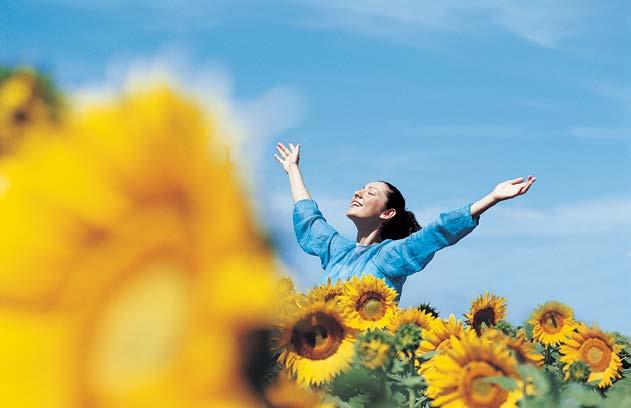
Make a meaningful impact in your community by becoming the owner of a Natural Awakenings magazine.
Empower others with current, valuable insights and resources to enhance their physical, mental, emotional and spiritual well-being.
As a franchise owner, you’ll inspire positive change, provide readers with tools for healthier living and connect local businesses with an audience eager for transformation.
Why Own a Natural Awakenings Magazine?
n Create a Healthier Community: Be the go-to resource for wellness and personal growth in your area.
n Boost Your Income: Take control of your financial future with a proven business model.
n Enjoy a Flexible Lifestyle: Work from home while pursuing a fulfilling, dynamic career.
n A proven business model with low startup costs.
n Comprehensive training and friendly, ongoing support.
n Flexible work schedule with many work-from-home opportunities.
n Access to a network of like-minded franchise owners.
n Financing Options Available.
Join a thriving network of passionate franchise owners reshaping the future of holistic health and wellness.
Call 239-206-2000 for a FREE evaluation of your community’s potential. Learn more or apply today at:
Corp.NaturalAwakenings.com
Own a business that

for a free evaluation of your community's potential at
To apply or learn more, visit Corp.NaturalAwakenings.com.
Add Your Community to Where Natural Awakenings Is Now Publishing:
• Atlanta, GA
• Boston, MA
• Broward County, FL
• Bucks/Montgomery Counties, PA
• Central Florida/Greater Orlando, FL
• Central New Jersey
• Charlotte, NC
• Chicago, IL
• Columbia, SC
• Dallas, TX
• Daytona/Volusia/Flagler Counties, FL
• Detroit/Wayne County, MI
• Fairfield & Southern Litchfield Counties, CT
• Grand Traverse Region/Northern Michigan
• Greater Ann Arbor, MI
• Greater Lansing, MI
• Greater Oakland, Macomb, Livingston, Genesee, MI
• Gulf Coast, Alabama/Mississippi
• Houston, TX
• Jacksonville/St. Augustine, FL
• Lancaster/Berks, PA
• Lehigh Valley, PA
• Long Island, NY
• Milwaukee, WI
• Monmouth/Ocean Counties, NJ
• Naples/Fort Myers, FL
• New York City, NY
• North Central New Jersey
• North New Jersey
• Northwest Florida
• Palm Beach, FL
• Philadelphia, PA
• Rhode Island
• Richmond, VA
• Sarasota, Manatee, Charlotte and DeSoto Counties, FL
• South Central Pennsylvania
• South Jersey, NJ
• Southeast North Carolina
• Space & Treasure Coast, FL
• Tampa, FL
• Tucson, AZ
• Twin Cities, MN
• Westchester/Putnam/Dutchess, NY
• Western Michigan

Be sure to let our ad partners know you found them in
Publisher Jordan Peschek
Editor Randy Kambic
Design & Production Suzzanne M. Siegel
Sales & Marketing Jordan Peschek
Website Nicholas Bruckman
Distribution Metro Periodical Partners
CONTACT US
Sales: 262-623-7948
Publishing/Editing: P.O. Box 2413 Brookfield, WI 53008-2413 Ph: 262-623-7948
Publisher@NATwinCities.com NATwinCities.com
As the last leaves fall and daylight shortens, I find myself craving stillness—the kind that comes when the world outside begins to hush. Nature is already modeling what so many of us forget: the rhythm of rest. Yet inside, our calendars tell a different story. The pace quickens with holiday plans, community events and the quiet pressure to fit it all in before year’s end.
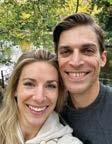
This month’s feature, “The Burnout Reset”, invites us to rethink what productivity really means in this season of darkness and renewal. Writer Hannah Tytus explores how we can align our inner pace with nature’s slower rhythm, embracing boundaries, breath and intentional rest as tools for wholebody recovery. It’s a timely reminder that we are not meant to operate on constant summer energy. Winter asks something gentler of us—something quieter and deeply restorative.
As you read, you’ll also find inspiration for nurturing your mind-body connection through recovery modalities like sauna, massage and acupuncture in “Tools for Fitness Recovery”. For those seeking balanced nourishment, “Balancing Act” offers insights on stabilizing blood sugar to steady both mood and energy throughout the day. Our homes, too, can play a role in this seasonal reset—“Indoor Oasis” shares how houseplants can transform the winter blues into calm, green comfort.
CEO Kimberly B. Whittle
CMO Vee Banionis
Sr. VP Operations Brian Stenzler, DC
National Sales Darleene Lee
National Editor Sandra Yeyati
Editor Brooke Goode
Copy Editor Melanie Rankin
Print Production Specialist Kevin Rankin
Design Director Agnes Mazeikaite
Production Flip180
Customer Service Dani Bucad
CONTACT US
Natural Awakenings Publishing Corporation 350 Main Street, Suite 9B Bedminster, NJ 07921 Ph: 239-206-2000
NaturalAwakenings@KnoWEwell.com
image courtesy of
© 2025 by Natural Awakenings. All rights reserved. Although some parts of this publication may be reproduced and reprinted, we require that prior permission be obtained in writing. Natural Awakenings is a free publication distributed locally and is supported by our advertisers. Please call to find a location near you or if you would like copies placed at your business. We do not necessarily endorse the views expressed in the articles and advertisements, nor are we responsible for the products and services advertised. Check with a healthcare professional regarding the appropriate use of any treatment. AI was used in some editing and production of this issue.
Natural Awakenings is printed on partially recycled and fully recyclable newsprint with black soy ink.
Whether you’re lighting candles at dusk, tending to your own energy with care, or creating warmth for others, may this issue serve as an invitation to slow down and reset. The season ahead isn’t asking us to do more—it’s asking us to listen.
Wishing you a peaceful November,






The Quantum Learning Academy, co-created by Dr. Theresa Bullard-Whyke and Alan Whyke, brings two in-person trainings to Bloomington, Minnesota in April 2026 to fully experience quantum mindset.

On Saturday, April 18, participants can experience iQuantum Changes, a one-day event to learn how to identify and clear limiting patterns of thought, explore the biology and alchemy of change and engage in grounded practices that cultivate resilience and flow.
For those seeking an even more immersive experience, Dr. Theresa and Alan will be sharing a four-day immersive program April 19-22 through the iQuantum Awakening. Delivering a fun-filled, energetic, educational experience like no other, this transformative journey uses quantum awareness, coherence and sacred geometry to awaken your Quantum Self and align you with infinite possibility.
Early registration for iQuantum Changes is $250 for the first 30 participants, with standard pricing at $350. The full retreat for iQuantum Awakening is $1,875, with a $400 discount for those who register by December 31. For more information or to register, visit DrTheresaInMN.com
Last month, Vanessa Nordstrom completed her training to become one of only five certified Spinal Flow practitioners in Minnesota. Vanessa is the founder of FYT Health & Wellness, in Eden Prairie, and she plans to share the benefits of the Spinal Flow Technique in her practice.
“It is a groundbreaking modality that helps the body reconnect, release stress and restore balance,” she explains. Vanessa will integrate this powerful practice alongside the Emotion Code, Body Code, Belief Code, along with frequency-based tools like the Healy and AO Scanner to support holistic healing for both humans and animals.

Vanessa explains that each Spinal Flow session includes an assessment, a 20 to 30-minute treatment and a reassessment, during which she serves as a facilitator to help the spinal column and brain communicate in order to help the body to release layers of physical, emotional and chemical tension. Developed by Dr. Carli Axford after two decades of clinical research, the technique aligns with the principle that “the power to heal is inside all of us.”
To learn more about Spinal Flow or schedule a session, visit FYTHealthWellness.coach. See listings on pages 29 and 31.

Caring Hands Massage & Spa is a wellness destination thoughtfully created by Judith Kulla and David Mueller. What began as a serendipitous connection—two massage therapists meeting through a personal ad—has blossomed into a holistic haven centered on balance, care and connection.
Planet Gratitude Chiropractic, a beloved wellness center in the community, announces the relocation of its Bloomington, Minnesota office to Barbados. Founder Dr. Una Forde, DC, expresses gratitude to patients and the community for over 25 years of support as she prepares to continue her holistic practice abroad.

Caring Hands offers an array of experiences designed to nurture body and soul. These include massage therapy to ease relaxation, help recover from injury, releasing emotional energy stuck in the body, relieve pain and cope with stress. They also provide Ayurvedic services involving personalized herbal consultations, holistic nutrition and luxurious spa services. Clients can also explore SoulBody Path sessions with Jeanne Lecher, and The Suite Experience that pairs energy and massage healing. Each offering invites guests to relax, rejuvenate and reconnect with their natural vitality. The wellness center is currently accepting new clients.
Judith and David, joined by their “Family of Healers,” emphasize authenticity over routine, ensuring each session is tailored to individual needs. Their philosophy is simple yet profound: “We care more.” Visitors can explore services, view amenities and book appointments online
Location: 427 Vermillion St., Hastings. For more information or to make an appointment, call 651-480-8244 or visit ByCaringHands.com. See ad on this page.
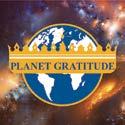
Known for integrating chiropractic care, acupuncture, acupressure, stretching, supplements and massage, Planet Gratitude also featured the Planet Gratitude Comedy Club, where laughter is embraced as a vital part of healing. Natural Awakenings expresses deep thanks for their service to the community for many years and wishes them all the best on their journey.
For more information, visit Planet-Gratitude.com.

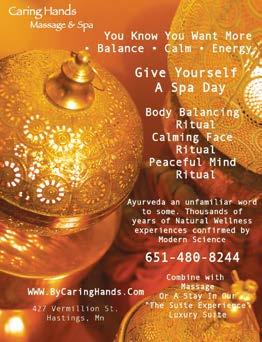
Kundalini yoga focuses on personal growth and spiritual connection through movement, breathing, meditation and sound in the form of mantras or chants. A 2024 study in Translational Psychiatry examined its potential to help older women at risk for memory problems and dementia.

The study involved 63 women aged 50 and older that were experiencing early memory decline and increased dementia risk due to conditions like high blood pressure or diabetes. Participants were randomly assigned to either a kundalini yoga group or a memory enhancement training (MET) group. The MET group performed verbal and visual memory-building exercises. All of the women met weekly with an instructor and practiced for 12 minutes daily at home over 12 weeks.
The yoga group reported greater improvements in how they felt about their memory. Gene testing showed beneficial changes in biological pathways linked to aging and inflammation in the yoga group, which were absent in the MET group. Additionally, levels of a harmful inflammation-related protein rose in the MET group but remained stable in the yoga group.
Brain scans of a subset of participants indicated that the yoga group experienced increased brain size linked to memory, as well as enhanced connectivity between memory-related brain regions, while the MET group showed shrinkage in these areas.

Researchers at the University of California San Diego and Dartmouth College used advanced brain imaging and artificial intelligence to study how various interventions influence the brain’s perception of pain. The 2025 study, published in Biological Psychiatry, analyzed data from two previous trials involving 115 healthy adults randomly assigned to one of four groups.
The mindfulness meditation group was taught breathwork and how to observe their thoughts and feelings without judgment. The sham-mindfulness group did not receive proper mindfulness instructions. The placebo cream group received a cream without active ingredients. The control group listened to an audiobook. Each group completed four, 20-minute sessions of their assigned activities, followed by brain scans while pain was applied to their leg.
The researchers discovered that mindfulness meditation significantly reduced pain intensity and unpleasantness more than the other groups. Brain scans revealed that mindfulness meditation decreased activity in neural patterns associated with both physical pain and emotional response to pain.
These findings suggest that mindfulness meditation reduces pain by directly altering sensory and emotional pain processing in the brain, whereas the placebo effect changes pain expectations. Further research is needed to confirm that mindfulness meditation can produce similar results for people with chronic pain.

A recent study in The Lancet Planetary Health assessed air pollution exposure in more than 750 pregnant women in Barcelona, Spain, using neurosonography imaging to examine their baby’s fetal brain structure during the third trimester. Researchers measured the mothers’ exposure to nitrogen dioxide, fine particles and black carbon at home, work and during daily travel. Black carbon forms when fossil fuels, wood or biologic materials burn incompletely. The study revealed that higher exposure to these pollutants was linked to changes in the shape and size of certain brain structures. Fetuses exposed to higher levels of black carbon had larger fluid-filled spaces in the brain, a larger cerebellum and a shallower fold in the brain known as the Sylvian fissure. These changes suggest slower or altered brain development. The study also found that fetal brains may be most sensitive to the effects of pollution during the second and third trimesters of pregnancy.



Researchers from Durham University in England surveyed more than 1,000 scientists, both astrobiologists and non-astrobiologists, to assess their beliefs about the existence of basic, complex and intelligent life beyond Earth. Their findings were published in nature astronomy. Almost 87 percent of astrobiologists agreed or strongly agreed that at least basic extraterrestrial life likely exists in the universe, while less than 2 percent disagreed and 12 percent remained neutral. Similarly, more than 88 percent of other scientists concurred that other life forms exist.
These results align with mathematical reasoning. With an estimated 100 billion galaxies in the universe, each containing billions of stars, and our understanding of habitable planets and moons, the probability of no other life forms existing is less than one in a billion billion (1,000,000,000,000,000,000).

A study in the journal Science examined the movement of plant species in Mesoamerican cloud forests, which span the mountain ranges of Mexico and Central America where warm Pacific air meets cooler Caribbean air. Despite occupying only 0.4 percent of Earth’s land, they are diverse ecosystems containing about 15 percent of all birds, mammals, amphibians and tree fern species.
Using satellite images and data from the Global Diversity Information Facility, scientists tracked plant movement in these forests. They discovered that plants have been moving up the mountains at a rate of six to nearly nine feet per year since 1979 due to rising temperatures. Scientists worry that these ecosystem changes could lead to biodiversity loss and changes in the water cycle. Without the storage and release of water by the cloud forests, downstream farms and drinking water could suffer negative impacts.

A team led by scientists from the University of Oxford has developed a more accurate method of counting wildebeest herds crossing Tanzania’s Serengeti and Kenya’s Masai Mara each year. For years, population counts relied on aerial photographs of the herds and extrapolation techniques that were prone to error if herds moved between survey areas or clustered unevenly. The new approach trains artificial intelligence (AI) models to count wildebeest and applies this knowledge to satellite images taken above Tanzania and Kenya.

The traditional estimate of the wildebeest population was 1.3 million, but the new AI models estimate the population to be between approximately 325,000 and 525,000. Researchers do not believe the population has collapsed. The difference may stem from altered migration patterns due to human encroachment on migration corridors and changes in grazing areas caused by climate change. Nevertheless, accurate population data is crucial for conservation planning.
November signals a reminder of a slower, quieter pace; when small, steady habits carry landscapes into winter. Thin layers of fallen leaves can be mow-mulched into turf for a natural composting effect. Many perennials benefit from being left standing until spring. Seed heads feed birds and hollow stems shelter pollinators. Add a thin layer of mulch, shredded leaves or compost to garden beds and tree roots.

Evergreens enjoy one last deep watering before the ground freezes to help them ride out dry winter winds. Clear gutters and direct downspouts toward lawn or a rain garden to keep meltwater where soil can use it.
Tools deserve attention, too. Hoses should be drained and stored, spigots shut, pruners cleaned and oiled, mower fuel stabilized and blades sharpened.
For icy days, protect pathways with salt-free traction. Apply salt-free, chloride-free de-icers only and use sparingly. Lean on sand or grit where possible.
Take time in November for a few simple rituals that hold habitat in place, keep soil fed and make tools ready for the return of a healthy and vibrant spring landscape.

Patti Beres is the owner of Be Green Pro LLC, sustainable landscape services, in southeastern Wisconsin. Call 262-361-4034 or visit BeGreen.pro


by Hannah Tytus
It’s six o’clock in the evening, and the sun has already set. The body is whispering for a warm cup of tea and rest, yet the to-do list stretches on: emails and carpools, fundraisers and school practices, appointments and dinner still to be cooked. The desire for rest is overridden by our self-imposed need to get it all done. The colder season, however, brings an opportunity to shift how we see rest and productivity, inviting us to move in harmony with the cycles of nature.
“Our culture has fed us the myth that we can grow and achieve ceaselessly,” explains Kari
Leibowitz, Ph.D., a psychologist, speaker, workshop facilitator and author of How to Winter. “The idea that this growth is linear and steady, with no breaks, is a myth and a fantasy. So much of the winter woes and the burnout of the season comes from a mismatch between our natural rhythms, our expectations and the demands of the world. Winter is an invitation to slow down.”
As with every other living being, we are intimately connected to nature’s cycles. “We are animals, and we live on a planet. And
almost every other living thing on this planet changes its behavior with the seasons,” observes Leibowitz. “Because we have electricity, artificial light and calendars, we have deluded ourselves into thinking that we can—and should—maintain the same routines and productivity levels year-round.”
This spirit of connectedness is echoed by Shamini Jain, Ph.D., adjunct professor at the University of California San Diego, founder of the Consciousness and Healing Initiative, and author of Healing Ourselves: Biofield Science and the Future of Health. “When we own that we’re part of a universe that has its ebbs and flows, we pay attention to the seasons,” she notes, adding that Indigenous medicine and wisdom have long honored natural cycles, seeking to answer the same question we ask ourselves today: “How can I show up and be most efficient in my service?”
This ancient orientation toward seasonal rhythms is not just a philosophical concept. Anthropological studies suggest that our ancestors likely slept more in the cooler months, falling asleep soon after sunset and rising before dawn. They got the most


sunlight in the morning, aligning their body’s cycles with temperature and light cues provided by nature. Contrast this with modern life, where we stay active well after dark, are exposed to sleep-disrupting blue light, wake with alarms and regulate our environment with thermostats that erase natural temperature shifts. By structuring our lives around modern demands, we resist nature’s rhythms. The result, says Jain, is chronic stress, fatigue and burnout.
As autumn transitions into winter and the holidays approach, many of us face greater demands to cook, shop, perform, travel or coordinate complex schedules, yet our resources of time and energy remain the same—or even ebb—as daylight hours shorten and our bodies naturally slow down and produce less vitamin D because of a decrease in sunlight exposure.
“Whenever demands exceed resources, we become stressed,” says Dr. Sharon Grossman, physician and author of The Burnout Solution. Chronic stress has a cumulative effect on our bodies, causing what is known
as an allostatic overload, which, according to Yale Medicine, can lead to emotional exhaustion, cynicism, detachment, reduced creativity, brain fog, disrupted sleep, physical aches and pains, or even social withdrawal.
“We often think of stress as a thing that lives ‘out there’, but stress is actually an internal perception that we have. It’s not always about the circumstances themselves;
it’s about what you’re telling yourself about the circumstances that creates the stress,” explains Grossman.
A 2016 study in Anxiety, Stress, & Coping examined the effects of altering our perspective on stress. Participants were encouraged to see it as a potential source of energy and resilience, rather than harmful. Those that applied this change in mindset reported better moods, enhanced cognitive performance and healthier physiological responses during a stressful task.
Try this psychological exploration: Identify limiting beliefs by journaling about the specific fears and guilt that come with saying “no” to a request for help. Next time someone asks for something, politely decline and observe the outcome. Check if expectations of conflict or hurt were unfounded. This approach challenges limiting assumptions and helps us set healthier boundaries, thereby reducing stress and enhancing emotional well-being.
We often have countless ideas about how we should behave, and many of these beliefs hold us back. Grossman emphasizes that every “yes” adds to our demands. “If you’re going to say ‘yes’, understand why you’re saying it,” Grossman cautions. “It should serve

a purpose, because our resources are limited.” In practical terms, we have to either lower the demands we accept or increase our resources, such as time or support, to meet them.
For Leibowitz, setting boundaries becomes easier when guided by values. If we want Thanksgiving to feel lighthearted and memorable, that might mean skipping elaborate dishes, accepting a less-than-perfect home and prioritizing rest so we can be present and joyful.
When a new request comes in, pause and reflect on how it aligns with personal values. Consider whether we are acting out of pressure. Release such commitments to make room for a new, better-aligned invitation.
Simple breathing practices can profoundly calm the nervous system. “The point is to breathe—nice inhales, long exhales—and in letting out a long exhale, make a sigh of relief,” Jain advises, suggesting that sounds like “ooo” or “ahh” during exhalation enhance emotional release.
Just five minutes of intentional breathing can make a measurable difference. Studies have demonstrated that longer exhales stimulate the vagus nerve, activating the rest-and-digest system, while calming the fight-or-flight response. This reduces heart rate and blood pressure and signals the brain to relax.
Try this breathing exercise: Sit or recline comfortably. Inhale gently through the nose, then exhale through the mouth, allowing sound to escape—this can be a sigh, a groan or a vowel tone. With each round, allow the exhale to lengthen naturally, releasing tension.
According to Jain, “Singing, whether by yourself or in groups, helps harmonize the body’s rhythms, decreases inflammation and
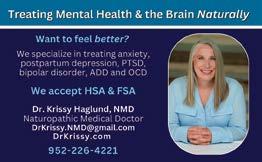
activates the nervous system’s rest-and-digest response.” A 2016 study by London researchers, published in ecancermedicalscience, demonstrated that just one hour of group singing reduced stress and improved mood, with saliva tests indicating lower levels of cortisol (the body’s main stress hormone) and changes in immune markers associated with resilience.
Bringing the benefits of song can be as simple as singing or humming a tune while washing dishes, showering or driving to work. Knowing the lyrics isn’t necessary; the vibrations alone create a positive resonance in the body.
Every breath we take is a dance between humans and plants. The oxygen they expel fuels us, and our exhaled carbon dioxide sustains them. This exchange is part of the deep bioelectric communication connecting us to the natural world.
“Fresh air, movement and connecting with nature are all natural antidepressants. Even a few minutes outside can be a powerful way to shift your experience,” says Leibowitz. A 2016 review of 52 Japanese studies found that spending time in nature measurably relaxes the body. Being around forests, plants or green spaces calms the nervous system, improves brain function, balances hormones and strengthens the immune system.
Try this outdoor palliative: Find a patch of earth and stand barefoot. With eyes closed, imagine releasing the day’s energies down into the ground. After a few breaths, visualize energy flowing back up, reinvigorating the body.
Mind-body-spirit practices offer powerful ways to find inner serenity. “They are effective in harmonizing the nervous system, reducing inflammation and opening our connection with heaven and Earth,” asserts Jain. Tai chi and qigong, which blend flowing movements with
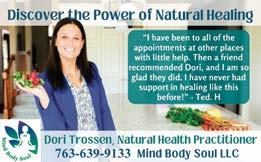

focused attention, breath and relaxation, have been shown in studies to pacify the overactive sympathetic nervous system and promote deep relaxation. Yoga offers similar effects. A 2020 review of 12 studies with nearly 675 healthy adults found consistent reductions in perceived stress, confirming yoga’s power to ease everyday tension.
Practicing these modalities under the guidance of a professional helps reduce risk of injury. Look for a tai chi, qigong or gentle yoga


class in the community. Many studios offer a free first class or sessions in a local park.
In a culture that glorifies hustle, reclaiming rest is an act of healing. Jain asserts, “We can move through the winter of our mind and body, allowing it to deeply rest so that when spring comes, we can move forward with more energy—for the right things, as opposed to everything.” Nature offers a model for this wisdom. Although the natural world seems to be still in winter, vital work occurs beneath the surface. Just as fruit trees need a cold dormancy period to bloom again, we also require periods of quiet renewal. Our cycles of stillness are as essential to growth, creativity and productivity as our cycles of action.
Rest is more than sleep; it is a way of tuning in. “When we slow down, it’s not just about regeneration,” explains Jain. “It’s about listening to the body’s wisdom, slowing down enough to access deeper intuitions and guidance about our next steps.” Our cycles of rest serve as a teacher. By slowing down, we gain the wisdom, focus and resilience to fully embrace a life renewed.
Hannah Tytus is an integrative health coach, researcher and content creator for KnoWEwell, P.B.C., as well as a former writer at the National Institutes of Health.


by Marlaina Donato
Approximately 34 to 36 million people in the United States live with Type 2 diabetes, yet many cases go undiagnosed. Additionally, about 88 million individuals have prediabetes, a reversible condition marked by higher blood sugar levels that have not yet reached diabetic status. Glucose stability is crucial for everyone and can be the root cause of symptoms like low energy (especially in the afternoon), mood swings, increased belly fat, food cravings, brain fog, hormonal imbalances and loss of libido.
Fluctuating blood sugar levels affect all of us, especially after high-carb meals or skipping meals. Our diet directly influences our metabolic processes. By choosing nutrient-dense foods, replacing high-sugar and high-carbohydrate snacks with healthier options and timing meals wisely, we
can achieve balance. Incorporating blood sugar-stabilizing spices and herbs into daily meals can also have a positive impact.
“Because glucose is a crucial fuel of the brain and body, there are many backup systems and ways to create glucose,” explains Iginio Stoppa, a naturopathic doctor at Sonoran University of Health Sciences, in Tempe, Arizona. “The absorption of glucose from our food, the production of glucose mainly from the liver and the breakdown of the storage form of glucose called glycogen is what contributes to what we see as blood sugar.” Stoppa also notes that we may notice when our blood sugar is off. Low blood sugar, for example, is often felt through symptoms like anxiety, weakness, tingling, sweating and palpitations.

“Everyone experiences natural rises and dips throughout the day. Skipping meals, leaning on caffeine for energy, eating a lot of refined carbohydrates or grabbing quick, processed snacks can all cause sharp spikes, followed by sudden crashes,” says Jennifer Ribaudo, a clinical herbalist, educator and owner of Desert Moon Botanicals, in Gilbert, Arizona.
It is advisable to avoid high carbohydrate and sugary foods, especially in the morning or before bed. Instead, opt for complex carbohydrates like lentils, beans, sweet potatoes and oats to provide essential macronutrients and prevent glucose spikes. Sonoran University recommends eating certain foods in a specific order, such as eggs or avocado before bread and roasted vegetables with olive oil before pasta, to manage glucose levels.
Jacqui Garrison, a San Diego-based health coach, suggests eating most calories before dinner and having an earlier, lighter evening meal to reduce overnight blood sugar spikes that can negatively affect sleep quality. She recommends 30 to 40 grams of clean protein per meal; if animal protein is included, five ounces or the size of a loose fist is ideal. Aim for two servings of leafy greens, colorful veggies or whole fruit per meal, equivalent to half the plate or two open hands. Add one to two thumb-sized portions of healthy fats such as avocado, olive oil or nuts to complete the meal.
For snacks, Garrison suggests a hardboiled egg or hummus with a handful of carrots, a cup of edamame in the pod or nitrite-free turkey slices in the afternoon. For an evening boost, she recommends “something light and protein-forward like half a cup of cottage cheese with cinnamon and berries.”
Stoppa supports high-quality protein and

naturally low-glycemic index foods like wild blueberries, blackberries and chickpeas, which provide polyphenols and saponins that slow glucose absorption.
Ribaudo emphasizes that blood sugar-supportive herbs can smooth out fluctuations. “Using herbs for blood sugar balance doesn’t have to be complicated. A little cinnamon can be stirred into oatmeal, blended into a smoothie or sprinkled into roasted vegetables or beans. Fenugreek seeds work beautifully in soups, curries and lentil dishes, while moringa leaf powder blends smoothly into salad dressings, sauces or soups.”
Ribaudo also recommends Gymnema

sylvestre tincture for pancreatic support and long-term glucose balance, making sugary foods less tempting. Stress-reducing holy basil (tulsi) tea is beneficial during afternoon slumps. She stresses the importance of consulting a professional, especially for those on blood sugar-lowering medications or prone to hypoglycemic dips, as effects can accumulate.
Marlaina Donato is an author, painter and composer. Connect at WildflowersAndWoodSmoke.com.
This is a perfect late-autumn breakfast or snack with protein, healthy fats and complex carbohydrates.
YIELD: 1 SERVING
½ cup organic rolled oats
1 Tbsp ground flaxseeds
¼ cup organic, unsweetened peanut, almond or sunflower butter
1 to 2 Medjool dates, finely chopped
¾ cup unsweetened coconut, almond or soy milk
½ tsp vanilla extract
½ tsp powdered Ceylon cinnamon
Place all ingredients in a bowl or Mason jar and stir well. Store overnight in the refrigerator for cold oats or on the counter for room-temperature oats in the morning.
Recipe courtesy of Marlaina Donato.
This delicious, nutrient-dense meal is packed with healthy fats, fiber and omega-3 fatty acids.
4 oz salmon
½ cup whole grain brown rice
½ cup edamame
½ cup carrots, shredded
½ cup cabbage or bok choy, shredded
½ Tbsp sesame seeds
1 Tbsp coconut liquid aminos
1 Tbsp rice vinegar
1 Tbsp scallions, chopped
1 Tbsp fresh cilantro, chopped
Cook the rice according to package instructions. Steam and shell the edamame. Sauté the cabbage or bok choy, if using. Grill the salmon and season to taste.
Layer cooked rice, edamame, carrot and cabbage or bok choy in a bowl. Add salmon.
Whisk coconut aminos and rice vinegar together then pour over the contents of the bowl and sprinkle with sesame seeds. Top with scallions and cilantro.
Recipe courtesy of Jacqui Garrison.

by Jordan Peschek, RN-BSN
In today’s fitness landscape, recovery extends beyond rest days. Holistic therapies are revolutionizing the way we approach physical restoration by integrating mental clarity, emotional resilience and energetic balance. From ancient techniques to cutting-edge innovations, these modalities offer comprehensive support for restoring harmony to body and mind. Selecting the best modality depends on personal preference and availability. Here are some popular recovery techniques.
Sauna Therapy: Infrared and traditional saunas can reduce inflammation; improve oxidative stress; alleviate pain, stiffness and muscle soreness; and improve perceived readiness or recovery time. In addition to its benefits for recovery, research suggests
that regular sauna therapy may reduce high blood pressure and the risk of heart disease, stroke and neurocognitive diseases.
Contrast Therapy: Exposing the body to alternating hot and cold temperatures, such as sauna therapy followed by a plunge in a cold-water bath, has become a staple in many athletic and integrative wellness settings. A 2023 systemic review published in PLoS One found that contrast water therapy significantly reduces muscle soreness.
Massage Therapy: Regular massages can support athletic performance. A 2020 systemic review and meta-analysis in BMJ Open Sport & Exercise Medicine involving more than 1,000 participants in 29 studies reported that massage improves flexibility

from
and delays muscle soreness. It also benefits emotional well-being by lowering stress and anxiety while improving mood and self-image.
Self-Myofascial Release: This technique uses foam rollers to massage the fascia—the connective tissue that wraps around muscles and organs. A 2024 review of 25 articles, conducted by researchers in Spain, found it improves flexibility and range of motion, decreases muscle soreness and enhances perceived recovery.
Chiropractic Care: This modality includes spinal manipulation, joint mobilization and soft tissue techniques to manage the health of athletes and non-athletes. By focusing on the musculoskeletal system, chiropractic adjustments promote optimal function and pain relief, while reducing muscle stress. This type of care is effective in treating common conditions, such as lower back pain, muscle strain and joint dysfunction, caused by fitness activities. Chiropractic care and spinal manipulation also support the regulation of the autonomic nervous system to ease depressive symptoms.
Acupuncture: A pillar of Traditional Chinese Medicine, acupuncture uses fine needles to stimulate energy points along the body’s meridians, decreasing muscle soreness and tension while increasing muscle activation to prevent injury. “Acupuncture helps relieve inflammation by lowering the levels of oxidative stress in the body,” explains Ayako Mizuno, a doctor of acupuncture and oriental medicine in Wauwatosa, Wisconsin. “It also stimulates the nervous and endocrine systems, which can help create calming and relaxing effects that reduce stress.”
Float Therapy: Also known as sensory deprivation, flotation involves a tank filled with magnesium-rich Epsom salt water, allowing the body to float effortlessly, free from external stimulation. This results in deep physical and mental relaxation. A

2024 randomized controlled study found that multiple sessions of float therapy were well-tolerated, safe for anxious and depressed individuals, and induced positive emotional experiences in individuals with anxiety and depression.
Compression Garments: These specialized elastic garments apply consistent, firm pressure to a body area to improve circulation, reduce inflammation and support recovery. A 2017 New Zealand meta-analysis found that compression garments benefited strength recovery following exercise. A 2022 study in Scientific Reports found that compression tights worn after exercise enhanced blood flow and recovery. Another systemic review and meta-analysis in 2025 concluded that these garments reduced the decline in muscle strength after exercise-induced muscle fatigue.
These therapies support the body’s natural healing abilities while honoring the deep connections between physical health, emotional regulation and energetic alignment. Integrating one or more of them may enhance physical recovery, emotional well-being and vitality. Listen to the body’s needs and explore the modalities that resonate most.
Jordan Peschek has a background in personal training, yoga instruction and mental health nursing. She publishes the Milwaukee and Twin Cities editions of Natural Awakenings.



by Christina Connors
Mornings set the tone for a child’s entire day. When rushed or chaotic, they can cause stress, fatigue and difficulty focusing in school. By using simple, intentional routines, mornings can become a source of grounding, positivity and energy, helping kids feel calm, nourished and mentally prepared for the day ahead.
Research confirms what many parents intuitively know: Consistent routines significantly impact a child’s development. “Morning routines create rhythm and predictability, which lower stress and help kids feel safe,” says Dr. Joel Warsh, an integrative pediatrician in Los Angeles. “A calm start sets the tone for better focus, mood and energy throughout the school day.”
A 2024 systematic review published in the Journal of Family Theory & Review found that childhood routines are linked to improved cognitive ability, self-regulatory and executive function skills, enhanced social and emotional skills, and better academic outcomes.
The morning meal is vital for sustaining vitality and focus throughout the school day. To stabilize blood sugar and support steady energy, Warsh recommends combining protein, healthy fats and fiber, such as eggs with avocado, chia pudding with berries or a smoothie with spinach and nut butter. This nutritional approach aligns with research showing that proper breakfast consumption directly impacts classroom behavior and academic performance, with students

demonstrating improved attention and participation when well-nourished.
Movement Connection
Incorporating gentle movement into morning routines achieves more than physical activity. “Short bursts of movement like stretching, yoga or dancing help release nervous energy and signal to the body that it’s time to focus. They also regulate mood and attention,” notes Warsh.
But too much too quickly may not have the desired effect. “Movement will get the blood moving and support in transitioning. But I wouldn’t go from no movement to awake to ‘let’s hustle’. The shift cognitively can become overwhelming,” advises Dr. Isaura González, a clinical psychologist and educator. She suggests a gradual approach, using an alarm with lighting options that slowly transition from dark to bright, and soothing music that supports the nervous system, rather than overstimulating it.
Successful mornings begin the night before. “Good sleep hygiene is the foundation for calm mornings,” emphasizes Warsh. “When kids sleep enough, their mood, focus and cooperation improve dramatically. Set out clothes, prep breakfast, pack lunches and keep backpacks by the door. These small steps prevent chaos and free up space for connection in the morning.”
Organizing a child’s activities takes this preparation further. “Getting a calendar with the month’s school activities is crucial.

You don’t want to miss the green T-shirt day, and then we have a meltdown,” says González. She suggests placing a calendar in a common area such as on the refrigerator so children can independently reference upcoming events.
Sustainable morning routines thrive on cooperation, rather than forced compli ance. “Add playfulness and use music,
countdowns or games to get tasks done,” recommends Warsh. “Kids are more engaged when mornings feel fun, rather than rushed.”
Involve children in routine creation. “Empowerment is the long game. By doing this, you are scaffolding the behavior, letting them do with your support,” adds González. “Children will often surprise even the most involved parent when you include them in
asking for their ideas. As they grow, they will need less and less support, and that’s okay because they will always need you.”
When developing a routine, ensure that it adapts to the child’s age and developmental stage. Warsh offers a simple template: “Wake up, open blinds for morning sun, make the bed, brush teeth, get dressed and eat a nourishing breakfast. End with a hug as you head out the door.”
Both experts agree that successful morning routines require patience and creativity, but the investment pays off in a child’s daily energy, mood and school readiness. With a little effort, families can transform their mornings from sources of stress into launching pads for successful, joyful days.
Christina Connors is a writer, keynote singer and head of music and SEL integration for the Kind Mind Education Program. Learn more at ChristinaConnors.com
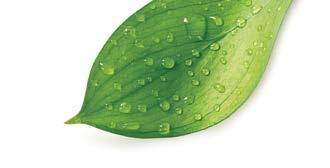




by Ruth Roberts, DVM, CVA, CVH, CVFT, NAN
Virtual care, including online consultations with licensed veterinarians and wellness professionals, has become essential in modern pet health. While many pet parents are familiar with telemedicine, teleadvice is less understood. Comprehending their differences and limitations is important.
The American Veterinary Medical Association defines telemedicine as patient-specific medical care delivered by licensed veterinarians with an established veterinarian-client-patient relationship, which typically requires an in-person examination before a veterinarian can legally diagnose, prescribe or treat via virtual platforms. It complements in-person care, merging professional expertise with convenience.
Through telemedicine, veterinarians can diagnose common health concerns, recommend treatments, prescribe medications where permitted by law and provide follow-up care for ongoing conditions. Everyday issues such as skin irritations, minor allergies, digestive upsets, appetite changes and certain behavioral questions can often be addressed in a video

consultation, giving pet owners reassurance and a clear plan of action. For animals with chronic conditions, virtual check-ins provide a stress-free way to monitor progress without frequent clinic visits.
Telemedicine services are most trusted and valued when delivered by a familiar veterinary provider. A 2024 randomized, controlled clinical trial in the Journal of the American Veterinary Medical Association found that pet owners are highly satisfied with telemedicine conducted by their regular veterinarian and prefer video-based recheck examinations after routine procedures. These findings support earlier research in Preventive Veterinary Medicine indicating that pet owners are willing to pay for telemedicine services provided by their own veterinarian.
Any consultation with non-veterinary professionals or pet health experts is considered teleadvice. It is educational, offering guidance such as encouraging annual wellness exams, promoting year-round parasite prevention or supporting better nutrition and lifestyle choices. While it can enhance a pet’s well-being, teleadvice does not involve diagnosing, prescribing or treating an animal.
Complementary teleadvice can add real value to a pet’s well-being, especially when delivered by certified professionals. Recent research in Frontiers in Veterinary Science demonstrated how video appointments

improved cat parents’ understanding of their pet’s chronic mobility challenges and the application of at-home management strategies. Many pet health coaches deliver their services exclusively through online platforms. These virtual sessions can guide pet parents through dietary planning, safe exercise routines or stress reduction strategies.
Laura Muzal, a holistic intuitive animal practitioner and certified holistic pet health coach, offers virtual consultations focused on nutrition, lifestyle support and energy work. “Meeting with pet parents virtually allows me to understand their concerns in real time, support them from anywhere and help them create simple, practical steps they can follow at home to support their animal’s well-being,” she says.
From the pet parent perspective, online consultations can still be done with compassion while providing ample time to explain strategies and answer questions. Muzal says that pet parents describe
feeling more confident and empowered to address their pet’s recurring health concerns after their virtual sessions. She also gets feedback that pet parents find their pets are calmer and more balanced with online meetings.
With the convenience of virtual consultations comes the responsibility to stay informed. Not every professional offering advice online operates under the same legal or ethical framework. Before booking any virtual consultation, pet parents must confirm who they are speaking with and under what authority they operate. Verifying whether the provider is a licensed veterinarian or a certified pet health expert helps ensure the advice given is appropriate and trustworthy. This clarity allows pets to receive the right care from the right expert at the right time.
Ruth Roberts is an integrative veterinarian and a holistic health coach for pets, as well as the creator of The Original CrockPet Diet. Learn more at DrRuthRoberts.com.


by Maya Whitman
As winter draws near and we seek refuge indoors, many of us notice a dip in physical energy and emotional well-being. Houseplants offer more than aesthetic appeal in our homes and workplaces; they rebalance our indoor environments and foster inner calm. Whether it’s a lush philodendron cascading from a bookcase or an elegant orchid on a coffee table, plants infuse life into any space.
With a variety of colors, sizes and maintenance levels, a green thumb isn’t required to create inviting, mood-lifting corners of greenery. Caring for plants can be an enjoyable, calming and uplifting experience, but simply being around them enhances our well-being. Research indicates that spending
time with houseplants lowers levels of the stress hormone cortisol, reduces worry and improves post-surgical outcomes in hospital patients.
Indoor plants transform the ambience wherever they are placed. “Their presence alone lifts mood. My home feels softer, calmer and more alive when plants are around me in winter. Even one thriving plant in your space can shift the energy,” says Dana Carpenter, a horticultural advisor and founder of the Fancy Plants Club, an online resource for successful houseplant management.
Plants add moisture to dry indoor air, benefiting skin and respiratory health during the

cold season. Varieties with broad, large leaves have a greater humidifying effect. For lush appeal and moisturizing benefits, choose dracaena, ficus benjamina, philodendron, peace lily, areca and bamboo palms. A 2005 study presented to the American College of Allergy, Asthma & Immunology suggests that English ivy is ideal for allergy sufferers because of its potential to reduce airborne mold spores.
“Plants are sensory by nature and stimulate the senses through touch, sight, sound, smell and taste,” says Alicia Green, a horticulturist and coordinator of Buehler Enabling Garden at the Chicago Botanic Garden. “Tending to a plant also subtly promotes a sense of responsibility and accountability that can contribute to emotional grounding.”
Carpenter agrees, stating, “When I am watering, pruning or just checking on my plants, my senses are engaged as I notice the texture of the leaves, the smell of soil, even the sound of water trickling. Caring for my plants offers a natural break in the rhythm of my day.”
Plants provide solace for those that find the colder months challenging, particularly individuals with seasonal affective disorder. “In the winter, when the light feels scarce and the days drag, even one corner filled with a few thriving plants, a cozy chair and maybe a grow light disguised as decor can change the energy of a room,” Carpenter reflects. “Just sitting near your green zone with tea in the morning turns it into a place you

look forward to, especially during gray months.”
Plants add comfort, warmth and support in spaces where we practice mindful meditation, prayer or yoga. Beautiful blooms beside photographs of loved ones celebrate happy memories. A group of plants in varying shades can transform a cozy reading nook, enliven a kitchen corner, add vibrance to a kids’ playroom or lend an exotic touch to a sunny bathroom.
Choosing the right plants that fit our individual lifestyles makes it easy to follow our bliss. “Snake plant tolerates very low light and can be placed in almost any room with a window. It
also has very low watering requirements, thus making it a very low-maintenance houseplant,” advises Green. “Pothos and peace lily can also be placed away from a window, as they are very tolerant of low light.”
Green also recommends using flowering plants such as amaryllis bulbs during winter months to add color to a room, and she encourages novice indoor gardeners to consider succulents and phalaenopsis orchids for their beauty and low-water requirements. Festive-blooming cyclamen is also a favorite for its tendency to thrive in autumn and winter.
According to Carpenter, all plants are joyful additions to the home, including fragrant herbs on a windowsill. “Brushing your hand across rosemary releases that fresh, grounding scent, which feels especially comforting when the world outside is cold and bare.”
Maya Whitman is a frequent writer for Natural Awakenings.
Beauty is only skin deep. I think what’s really important is finding a balance of mind, body and spirit.
—Jennifer Lopez

The Thanksgiving table offers a feast of our favorite dishes to share with loved ones, but this annual gathering can lead to food waste, increased energy use, more national travel and other unsustainable excesses. With some planning and simple adjustments, we can make the holiday more environmentally conscious. Reducing our carbon footprint is the best way to show our gratitude to Mother Earth.
• Assign others to bring specific dishes and remind them to use reusable containers for leftovers.
• Shop for seasonal produce and meats at nearby stores and farmers markets to minimize food travel.
• For turkey or other meats, choose pasture-raised and certified-humane options.
• For plant-based eaters, consider a savory lentil loaf, vegan bisques and satisfying baked squashes, including pumpkins stuffed with quinoa and roasted vegetables.
• Avoid packaged foods and make some things from scratch, such as quick baking-powder biscuits.
• To reduce food waste, save produce scraps such as the outer layers and ends of onions, carrot bits, celery leaves, mushroom stalks and herb stems to make vegetable broth for soups and gravies.
• Set the table with cloth napkins and reusable tableware.
• Inform guests of the recycling bin’s location.
• Drive on off-peak days for less stress,


quicker transit and less fuel wasted sitting in traffic. Consider taking a train or bus instead of flying or driving.
• When driving, bring reusable containers and water bottles for snacks and beverages.
• Decorate the table with leaves and dried plants from the yard, baskets of real grapes and other fruits, or beeswax candles.
• Express gratitude to each guest around the table for joining the celebration and for the qualities that make them special.
• Volunteer at a local food pantry or community Thanksgiving meal.
• Freeze leftovers, including soup, stuffing and desserts for subsequent meals and snacks.
• Pack up a generous plate or two for a neighbor, single mom or friend.
Wednesday, November 5
Ladies Night In: Heart Chakra Evening – 5:30-7:30pm. Enjoy deep relaxation in the EE System, a heart-opening session on the Opus sound bed, and time to gather with tea and conversation. An evening of healing, connection and selfcare. $55. 651-430-2866. Healing Waters Health Center, 6150 Oren Ave N, Stillwater. HealingWatersHealth.com
Thursday, November 6
Integrated Sound Bath with EES 6:30-7:30pm
Experience deep relaxation and healing through the combination of sound therapy and the Energy Enhancement System (EES). Facilitated by Ryan Wimperis of Amethyst Healing. Please bring a blanket, water bottle, and indoor shoes or socks. $65.
Healing Waters Health Center 6150 Oren Ave N, Stillwater 651-430-2866
HealingWatersHealth.com
Saturday, November 15
Wellness, Body, Mind & Spirit Expo
Saturday and Sunday, Nov. 15 and 16 10am-4pm
Celebrate wellness at this dynamic event featuring the latest in alternative and holistic health. Discover doctors, providers, coaches, psychics, astrologers, artists and more.
$8; free admission for veterans and kids under 12. Vendor booths available! 414-349-4932.
Holiday Inn Milwaukee River Front 4700 N. Port Washington Rd., Milwaukee WellnessBodyMindSpirit.com
Wednesday, November 19
Ladies Night In: Heart Chakra Evening – 5:30-7:30pm. Enjoy deep relaxation in the EE System, a heart-opening session on the Opus sound bed, and time to gather with tea and conversation. An evening of healing, connection and selfcare. $55. 651-430-2866. Healing Waters Health Center, 6150 Oren Ave N, Stillwater. HealingWatersHealth.com.
Thursday, November 20
Integrated Sound Bath with EES
6:30-7:30pm
Experience deep relaxation and healing through the combination of sound therapy and the Energy Enhancement System (EES). Facilitated by Ryan Wimperis of Amethyst Healing. Please bring a blanket, water bottle, and indoor shoes or socks. $65.
Healing Waters Health Center 6150 Oren Ave N, Stillwater 651-430-2866
HealingWatersHealth.com
Thursday, December 18
Integrated Sound Bath with EES
6:30-7:30pm
Experience deep relaxation and healing through the combination of sound therapy and the Energy Enhancement System (EES). Facilitated by Ryan Wimperis of Amethyst Healing. Please bring a blanket, water bottle, and indoor shoes or socks. $65.
Healing Waters Health Center 6150 Oren Ave N, Stillwater 651-430-2866
HealingWatersHealth.com
Vision Extravaganza: January 4-9, 2026. Manifest your dream life. Experience the Caribbean at its finest! Relax, have fun in the sun, and create a life you love. Registration $8,599. Includes conference attendance fee, five-night stay at Wyndham Grand All-Inclusive resort, Sam Lord’s Castle Barbados. Meals included. 952-922-1478. Planet-Gratitude.com

Friday Discover Your Highest Purpose Fridays at 7pm
Sri Harold Klemp, spiritual leader of Eckankar, shares wisdom through stories & spiritual insights that bring meaning, connection & humor to the workings of Spirit in everyday life. Watch on Channel 6 or via MCN6.org For more information, visit TempleOfECK.org or Facebook.com/Eckankar
Tai Chi Small Group Classes – Available Monday-Saturday. Enjoy mindful movement virtually from anywhere. Better Forever Training. 651-300-9735. BetterForeverTraining.com.
Tabata Small Group Classes
Available Monday-Saturday. High-intensity virtual workouts you can join from anywhere. Better Forever Training. 651-300-9735 BetterForeverTraining.com
ALIVE ‘N VIBRANT SUPERFOOD & PROTEIN POWDERS – 100% organic. Feel alive and vibrant no matter what your health history. Shop at your local Outpost Natural Foods or online: AliveNVibrant.com. See ad on page 8.
ORGANIC PANCREAS DETOX TEA –Cleanse & Support Your Pancreas with this Targeted Blend. Samples Available. Visit EarthSanaStore.com/tea
ORGANIC HERBAL TEAS – Targeted Herbal Teas for the Pancreas, Lymph, Liver, Kidneys, Prostate, Lungs, Heart & More. EarthSanaStore.com/Tea. 954459-1134. Samples available.
THE HEALTHIEST FOOD FOR YOUR PET – EVOLUTION DIET PET FOOD: 100% Natural and Organic pet food for dogs and cats. The best thing you can buy for your pet. Safe, highly awarded, non-GMO. Shop online at PetFoodShop.com
LIST YOURS HERE! $20 for 20 words. Text 651-300-2345 or email Publisher@ NATwinCities.com
Connecting you to the leaders in natural health care and green living in our community. To find out how you can be included in the Community Resource Guide, email Publisher@NATwinCities.com to request our media kit.
ALLOY ACUPUNCTURE
6053 Hudson Rd, Ste 152, Woodbury 920-838-1526
AlloyAcu.com

Acupuncture, cupping, herbal treatments, ultrasound and more brings patient focused, customized healing. Get treatment today for infertility, headaches, auto accident injuries, pain, anxiety and more! See ad on page 19.
CARING HANDS MASSAGE & SPA 427 Vermillion St., Hastings 651-480-8244
CaringHands@CreatingReality.com ByCaringHands.com

Offering holistic massage, spa, Ayurveda and more. Relax, relieve stress, restore balance and vitality with natural healing services. With personalized care, the practice provides rejuvenation that feels like a true retreat. It’s where you want to be and how you want to feel. Schedule a service or book an overnight stay with The Suite Experience By Caring Hands. See ad on page 7.
MYOFASCIAL RELEASE & CRANIOSACRAL THERAPY
Barb Ryan, CMT, CSD • 612-922-2389 Bhakti Wellness Center 7300 Metro Blvd., Suite 340, Edina WisdomSisterStudio.com

Specializing in persistent and chronic pain and mysteries of the body. Also for people seeking the experience of deep relaxation and increased self-connection. Skilled and compassionate care. See ads on pages 8 and 15.
MIND BODY SOUL, LLC
DORI TROSSEN
NATURAL HEALTH PRACTITIONER
763-639-9133 | BalancedDori.com

As a Health Coach and holistic practitioner, Dori guides clients to reach their health goals with individualized plans, bioresonance and complementary therapies that get to the root cause of issues to heal and stay well.
See ad on page 14.
SACRED OAKS HEALING
Sara Anondson 4161 Minnehaha Ave S., Rm 3, Minneapolis 612-255-4213
SaraAnondson@SacredOaksHealing.com SacredOaksHealing.com

Supports mind, body and soul through mentorship, doula work and holistic healing experiences and classes.
HEALTH CENTERED DENTISTRY
N7915-902 St, River Falls, WI 715-426-7777
HealthCenteredDentistry.com

Whole Person Dentistry observes and deals with the mind, body and spirit, not just your teeth. This approach to dentistry encompasses both modern science and knowledge drawn from the world’s great traditions in natural healing. See ad on page 6.
NATURAL SMILES DENTAL CARE
3434 Lexington Ave. N., Ste 700 Shoreview | 651-483-9800
NaturalSmilesDental.com

We’re an integrative practice committed to promoting dental wellness and overall assistance to the whole person. We desire to participate in the creation of healthier lives, while being sensitive to physical, philosophical, emotional and financial concerns. See ad on back cover.
SEDATION AND IMPLANT DENTISTRY
1815 Suburban Ave, St. Paul 651-735-4661 | ToothBuilder.com

We are a holistic dental practice devoted to restoring and enhancing the natural beauty of your smile using conservative, state-ofthe-art dental procedures that result in beautiful, long-lasting smiles! We specialize in safe removal of infected teeth, ceramic implants and restorations. See ad on page 23.
TOOTH BY THE LAKE
1401 Main St, Hopkins 952-475-1101 • ToothByTheLake.net

We build a foundation of trust by treating our patients as individuals. Understanding how uneasy some patients may feel about their dental visits, we make a difference by providing a relaxing and positive experience. See ad on page 21.
HAIR TISSUE MINERAL ANALYSIS SCIENTIFIC NUTRITION, LLC
Virtual Sessions, East Bethel 651-462-1555
Lisa@HairAnalysisNutrition.com HairAnalysisNutrition.com

Are you looking to get healthy? Hair Tissue Mineral Analysis (HTMA) will guide you with personalized nutrition & supplement recommendations, detoxification of heavy metals, lifestyle changes and one-to-one coaching. See ad on page 19.
CONCORDIA UNIVERSITY WISCONSIN School of Pharmacy Online Degree Program CUW.edu/NPS

Take the next step toward a career that makes a difference! Discover Your Future in Natural Product Sciences with our flexible graduate programs. Choose from a 30-credit online Master’s degree or a 12-credit graduate certificate, both designed to fit your life and goals. Specialize in medical cannabis or nutraceuticals, and prepare for exciting roles in health care, pharmacy, research and development, manufacturing, business and beyond. See ad on page 25.
HEALING WATERS HEALTH CENTER
6150 Oren Ave N, Stillwater 651-430-2866
HealingWatersHealth.com

We bring you back to your natural state of being; restoring energy flow in body and mind with hands-on treatments and cutting-edge technology. See ad on page 9.
EMOTION CODE HEALING
Master Hong
Certified Emotion Code Practitioner 11012 Cedar Lake Rd., Minnetonka 952-513-7285 or 914-708-9463

Chronic pain? Suffering from emotions? Relationship problems? Life not going as planned? The Emotion Code is a tool I use to help you break through any emotional and spiritual blocks so you can live your best life. Trial session is only $35.
F.Y.T. HEALTH & WELLNESS
Vanessa Nordstrom Eden Prairie, MN (in-office & distance sessions) 612-382-3653
FYTHealthWellness@gmail.com
FYTHealthWellness.coach

Offering a unique combination of 5 healing modalities for energy healing and trauma release with the Emotion Code, Body Code, Belief Code, Reiki and Healy sessions. I use Individualized Microcurrent Frequency (IMF) programs to harmonize the Bioenergetic Field.
Fitness
BETTER FOREVER TRAINING
Bobbie Drew 816 7th Ave S, St. Paul 651-300-9735
BetterForeverTraining@Outlook.com BetterForeverTraining.com

Online one-on-one personal training and small group fitness classes including tai chi and nutrition consultations. All services begin with a free initial consult and tech check.
SCIENTIFIC NUTRITION, LLC
Virtual Sessions, East Bethel 651-462-1555
Lisa@HairAnalysisNutrition.com
HairAnalysisNutrition.com

Are you looking to get healthy? Hair Tissue Mineral Analysis (HTMA) will guide you with personalized nutrition & supplement recommendations, detoxification of heavy metals, lifestyle changes and one-to-one coaching. See ad on page 19.
MASTEL’S HEALTH FOODS
1526 St Clair Ave, St. Paul 651-690-1692
Mastels.com

Mastel’s Health Foods is Minnesota’s oldest health and wellness store. We carry a full line of vitamins, minerals, supplements, herbs and more. We emphasize organic, biodynamic, biodegradable, holistic and hypoallergenic products, and pride ourselves on stocking hard-tofind items. See ad on page 15.
DR. KRISSY HAGLUND, NMD
Naturopathic Medical Doctor
DrKrissy.com
DrKrissy.NMD@gmail.com

Caring for patients skeptical of the conventional paradigm. Experienced treating mental health & the brain naturally: anxiety, depression, ADD, autism, behavioral disorders, postpartum, OCD and TBI. See ad on page 14.
GENEVIEVE WACHUTKA
7801 East Bush Lake Rd., Suite 240, Bloomington 763-222-8600
GenevieveWachutka.com

Genevieve specializes in the practical application of time-tested tools and metaphysical wisdom to embody more of your potential, and experience greater clarity, joy, and purpose in life. Benefits include increased intuition and clarity; upleveled daily baseline of joy; peace within your heart and mind; improved relationship with self; and the ability to navigate a path of self-mastery to realize your greatness. Text 763-222-8600 or email Hello@GenevieveWachutka.com to schedule a complimentary discovery session. See ad on page 7.
3209 W 76th St, Suite #303 Edina 612-564-2282
Infuse.Health

Infuse IV Wellness, in Edina, MN, offers IV hydration and vitamin treatments, NAD+ therapy, sermorelin, vitamin D optimization, and personalized weight-loss programs to rejuvenate your body, boost energy and enhance overall well-being.
790 Cleveland Ave. S, Ste. 224, St. Paul 612-662-5531
Info@LivlyWellness.com
LivlyWellness.com

A holistic approach to medically supervised weight loss with Semaglutide and Tirzepatide, IV infusions (in-clinic or mobile), hormone therapy, NutraFi vitamin sprays and pharmaceutical-grade supplements. See ad on page 15.
OPTIMAL WELLNESS SOLUTIONS
2489 Rice St N, Ste 130, Roseville 651-340-1233
RosevilleOptimalWellness.com

We provide a well-rounded menu of holistic, integrative healing practices to support your mind, body and spirt including massage, network spinal, craniosacral therapy, thermography, detox ionic footbaths, Reiki and footcare services. See ad on page 9.
DR. KRISSY HAGLUND, NMD
Naturopathic Medical Doctor Scott County, MN
DrKrissy.com
DrKrissy.NMD@gmail.com

Caring for patients skeptical of the conventional paradigm. Experienced treating mental health & the brain naturally: anxiety, depression, ADD, autism, behavioral disorders, postpartum, OCD and TBI.
See ad on page 14.
MYOFASCIAL RELEASE & CRANIOSACRAL THERAPY
Barb Ryan, CMT, CSD • 612-922-2389
Bhakti Wellness Center 7300 Metro Blvd., Suite 340, Edina WisdomSisterStudio.com

Specializing in persistent and chronic pain and mysteries of the body. Also for people seeking the experience of deep relaxation and increased self-connection. Skilled and compassionate care. See ads on pages 8 and 15.
DR. KRISSY HAGLUND, NMD
Naturopathic Medical Doctor Scott County, MN
DrKrissy.com
DrKrissy.NMD@gmail.com

Caring for patients skeptical of the conventional paradigm. Experienced treating mental health & the brain naturally: anxiety, depression, ADD, autism, behavioral disorders, postpartum, OCD and TBI. See ad on page 14.
INTEGRATIVE HEALTHWERKS
Dr. Audrey Schenewerk
651-447-7200
Info@IntegrativeHealthwerks.com IntegrativeHealthwerks.com

Here to guide you through hormone and metabolic imbalances, gastrointestinal disorders and symptoms, autoimmune conditions, chronic fatigue, and those who want to optimize health and prevent disease.
ALIVE N VIBRANT
Superfood and Protein Powders
AliveNVibrant@gmail.com AliveNVibrant.com

Locally made, 100 percent organic superfood powders to keep you feeling alive and vibrant no matter what your health history. See ad on page 11.
PROFESSIONAL LISTENING
Barb Ryan, CSD
Wisdom Listening
612-922-2389
WisdomSisterStudio.com

Longing for someone who will listen without judgment? Facing a tough decision and need a space to explore possibilities? Have some secrets corroding your being? Need a place to vent about loved ones without repercussions? Wisdom Listening can help. It’s not therapy or coaching. My sole objective is to provide a safe and supportive space for you to unburden and explore your mind, heart, and soul. Book your virtual session now. See ads on pages 8 and 15.
OPTIMAL WELLNESS SOLUTIONS
2489 Rice St N, Ste 130, Roseville 651-340-1233
RosevilleOptimalWellness.com

We provide a well-rounded menu of holistic, integrative healing practices to support your mind, body and spirt including massage, network spinal, craniosacral therapy, thermography, detox ionic footbaths, Reiki and footcare services. See ad on page 9.
CARING HANDS MASSAGE & SPA
427 Vermillion St., Hastings
651-480-8244
CaringHands@CreatingReality.com ByCaringHands.com

Offering holistic massage, spa, Ayurveda and more. Relax, relieve stress, restore balance and vitality with natural healing services. With personalized care, the practice provides rejuvenation that feels like a true retreat. It’s where you want to be and how you want to feel. Schedule a service or book an overnight stay with The Suite Experience By Caring Hands. See ad on page 7.
ECKANKAR TEMPLE OF ECK 7450 Powers Blvd., Chanhassen 952-380-2200
TempleofECK.org

Are you looking for the personal experience of God? Eckankar can help you fulfill your dream. We offer ways to explore your own unique and natural relationship with the Divine through personalized study to apply in your everyday life.
OPTIMAL WELLNESS SOLUTIONS
2489 Rice St N, Ste 130, Roseville 651-340-1233
RosevilleOptimalWellness.com
We make a living by what we get, but we make a life by what we give.
—Winston Churchill

We provide a well-rounded menu of holistic, integrative healing practices to support your mind, body and spirt including massage, network spinal, craniosacral therapy, thermography, detox ionic footbaths, Reiki and footcare services. See ad on page 9.
F.Y.T. HEALTH & WELLNESS
Vanessa Nordstrom Eden Prairie, MN (in-office & distance sessions) 612-382-3653
FYTHealthWellness@gmail.com
FYTHealthWellness.coach

Offering a unique combination of 5 healing modalities for energy healing and trauma release with the Emotion Code, Body Code, Belief Code, Reiki and Healy sessions. I use Individualized Microcurrent Frequency (IMF) programs to harmonize the Bioenergetic Field.
CARING HANDS MASSAGE & SPA
427 Vermillion St., Hastings 651-480-8244
CaringHands@CreatingReality.com ByCaringHands.com

Offering holistic massage, spa, Ayurveda and more. Relax, relieve stress, restore balance and vitality with natural healing services. With personalized care, the practice provides rejuvenation that feels like a true retreat. It’s where you want to be and how you want to feel. Schedule a service or book an overnight stay with The Suite Experience By Caring Hands. See ad on page 7.
HEALING WATERS HEALTH CENTER
6150 Oren Ave N, Stillwater
651-430-2866
HealingWatersHealth.com

We bring you back to your natural state of being; restoring energy flow in body and mind with hands-on treatments and cutting-edge technology. See ad on page 9.
OPTIMAL WELLNESS SOLUTIONS
2489 Rice St N, Ste 130, Roseville 651-340-1233
RosevilleOptimalWellness.com

We provide a well-rounded menu of holistic, integrative healing practices to support your mind, body and spirt including massage, network spinal, craniosacral therapy, thermography, detox ionic footbaths, Reiki and footcare services. See ad on page 9.

January Nurture


Be sure to let our ad partners know you found


• Mercury / Amalgam / Silver Filling Removal
• Biocompatible Dental Materials
• Orthopedic Orthodontics
• Tongue & Lip-Tie Revision
• Ceramic / Biocompatible Implants


• Biological Extractions with PRF
• Ozone Therapy
• Invisalign
• Myo-Functional Therapy
• Craniosacral Therapy
• BioMeridian Testing
• Acupuncture

• Dynamical Neurofeedback 3434 Lexington Ave. N Shoreview, MN 55126 (651) 483-9800 www.NaturalSmilesDental.com
